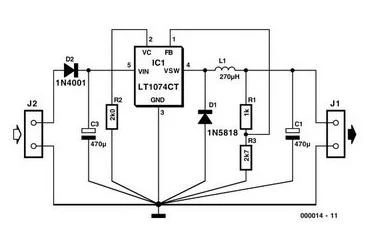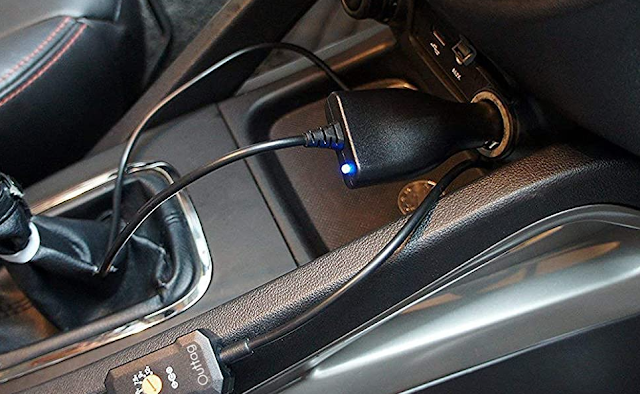Find the best antennas for TV, radio, and wireless. Compare top antenna deals, use free antenna calculators, follow DIY guides, and buy high-performance antennas with confidence.
Free Energy : Centrifugal dynamic power generating system using a lever structure Patent
A MUST Have Gadget in Everyone's Car!



Don't Panic If Phones or Laptop Power Run Out, This Car Power Inverter will Solve your Problem
If you travel by car, in the down town city, or more outside the city, now you don't need to be afraid if you run out the power of cellphones or laptop batteries and for other purposes, such as TVs, cameras, beard shaves, now there is a Car Power Inverter from NDDI with 200 Watt Output Power and 400 Peak Power, there is also a car power inverter with 400 Watt and 600 Watt output power, 12 VDC to 110 V AC, lightweight and portable. If you use this car power inverter please pay attention to these lists :
Avoid operate the inverter while hand is wet. Avoid input the AC to the power inverter.
Avoid using products that exceed the peak value of the product.
Avoid use cigarette lighter plug when using inverter on device over 200w.
Avoid leaving the power inverter in the "ON" states while your car is "OFF".
Avoid prolonged exposure to sunlight, resulting in excessive product temperature or scald.Check it Out !
Zero Energy Device Example
For example, consider a crystal set radio receiver:
Looking at this in isolation, we appear to have a free-energy system which contradicts the Law of Conservation of Energy. It doesn’t, of course, but if you do not view the whole picture, you see a device which has only passive components and yet which (when the coil is of the correct size) causes the headphones to generate vibrations which reproduce recognisable speech and music.
The whole picture is:
Reference :https://www.free-energy-info.com/
Free Electricity Using Magnet and AC Motor
3 Volt Car Adapter
Electrochemical Liquid Vortexing Ionization System
Mixed 1/2 teaspoon of copper wire, aluminium wire,and zinc galvanized or stainless steel and break up the neodymium magnet mixed it.
You can find copper wire from old transformator,or old electric motor, and for aluminium you can use from coke can, for stainless steel you can use from coin or spoon or you can buy stainless steel wire,and neodymium magnet you can find it from old hard drive.
This is only my suggestion,maybe you have better ideas for find the ingredients for this project.
My Ilustration of this device :
The Installation :
On his experiment,this device proved can reduce or saving the use of gasoline or diesel,and also reduce the CO Emission to the air. Last, I will post my experiment with this device on my diesel car to you.
Free electricity from Air
Free Electricity from Air Using Tesla Radiant Energy – OA70 / IN34 Germanium Diode Circuit Explained
Free electricity from air is one of the most searched alternative energy topics inspired by Nikola Tesla radiant energy research. While unlimited free energy is not scientifically proven, it is possible to detect and harvest extremely small amounts of atmospheric electrical energy using simple circuits with OA70 or IN34 germanium diodes.
This in-depth guide explains the theory, history, circuit design, safety, and components required to build a Tesla-inspired radiant energy experiment suitable for education and research.
⚠️ Educational Disclaimer
This article is for educational and experimental purposes only. The circuit described does NOT generate unlimited or over-unity power. Output energy is extremely small and intended only to demonstrate atmospheric electricity and diode rectification principles.
What Is “Free Electricity from Air”?
The term free electricity from air usually refers to harvesting naturally occurring electrical energy from:
- Atmospheric electric fields
- Earth–ionosphere voltage gradient
- Ambient RF (radio frequency) energy
- Electrostatic charge in the air
This energy already exists in nature but at very low power levels. Special components such as germanium diodes (OA70 / IN34) are used to capture and rectify these weak signals.
Nikola Tesla and Radiant Energy Theory
Nikola Tesla proposed that the Earth and atmosphere form a massive electrical system. In his patent “Method of Utilizing Radiant Energy”, Tesla described:
- An elevated metal plate (antenna)
- A capacitor for charge storage
- A rectifier to control electrical flow
Tesla believed sudden electrical impulses and environmental radiation could be accumulated and converted into usable electrical effects.
Why OA70 or IN34 Germanium Diodes Are Used
Germanium diodes are essential for radiant energy and atmospheric electricity circuits because they work with extremely low voltages.
| Diode | Forward Voltage | Application |
|---|---|---|
| OA70 | ≈ 0.2V | Radiant energy, signal detection |
| 1N34 / IN34 | ≈ 0.25V | Crystal radios, energy harvesting |
| Silicon Diode | ≈ 0.7V | Not suitable for weak signals |
This low forward voltage allows OA70 and IN34 diodes to rectify tiny atmospheric or RF signals that silicon diodes cannot.
Free Electricity from Air Circuit Using OA70 / IN34
Required Components
- OA70 or 1N34 germanium diode
- 0.01µF – 0.1µF capacitor (100V or higher)
- 1MΩ – 10MΩ resistor
- Metal plate or long wire antenna
- Earth ground (rod or water pipe)
- High-impedance multimeter
Simple Circuit Diagram
How the Circuit Works
- The antenna collects ambient electric charge.
- The germanium diode rectifies micro-volt signals.
- The capacitor slowly stores charge.
- The resistor stabilizes and protects the circuit.
Expected Results and Realistic Output
Typical results include:
- Millivolts to a few volts (open circuit)
- Extremely low current (microamps or less)
- Better response with higher antenna placement
This circuit is ideal for experimentation, learning, and demonstration, not for powering appliances.
Recommended Components (Affiliate Ready)
Below are commonly used components for building radiant energy and atmospheric electricity circuits.
| Component | Description | Buy Link |
|---|---|---|
| OA70 Germanium Diode | Low-voltage diode for radiant energy circuits | Check Price |
| 1N34 / IN34 Diode | Classic crystal radio diode | Check Price |
| High Voltage Capacitor | 0.01µF–0.1µF ceramic or film | Check Price |
| Ground Rod Kit | Proper earth grounding for experiments | Check Price |
| Digital Multimeter | High-impedance voltage measurement | Check Price |
Frequently Asked Questions
Can this circuit really produce free electricity?
No. It detects and stores extremely small amounts of naturally occurring energy. It does not violate physics.
Is this based on Nikola Tesla’s work?
Yes, it is inspired by Tesla’s radiant energy concepts but simplified for safe experimentation.
Why does weather affect the output?
Atmospheric charge density changes with humidity, altitude, and electrical conditions.
Final Thoughts
The idea of free electricity from air remains fascinating. Using OA70 or IN34 germanium diode circuits, hobbyists and students can explore:
- Atmospheric electricity
- Energy harvesting principles
- Tesla-inspired electronics
True power comes not from unlimited energy, but from knowledge, experimentation, and understanding physics.












